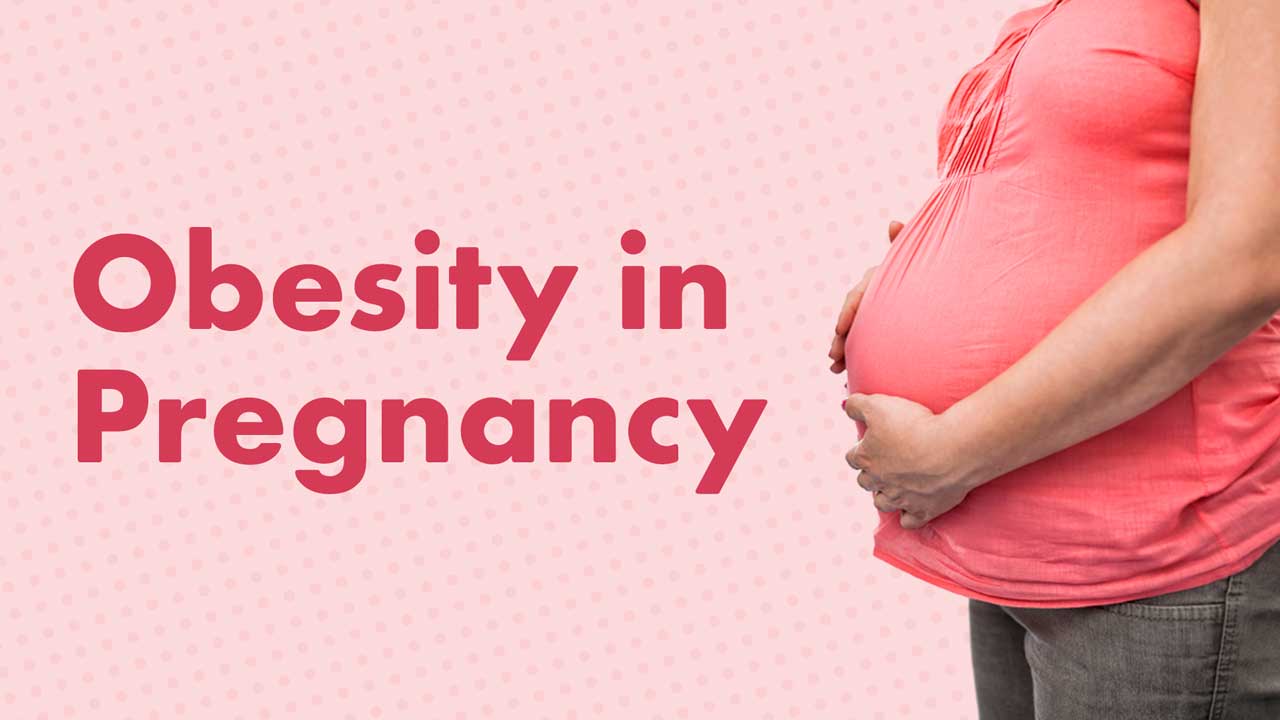In pregnancy, the challenges of being overweight can easily become magnified, placing both pregnant people and their babies at increased risk of perinatal morbidity and mortality.
Excessive Gestational Weight Gain
It’s well known that people entering pregnancy with a high body mass index (BMI) are at increased risk of excessive gestational weight gain (GWG) and postpartum weight retention. However, what is less well-known is the associated risk of childhood obesity in children born to people with excessive GWG (McDowell et al. 2018).
GWG doesn’t just include fat but also water, protein and minerals that are deposited into the placenta, fetus, uterus, amniotic fluid, mammary glands, blood and adipose tissue. Collectively, all of these components cause GWG to vary considerably between patients. (Olander et al. 2021).
Recommended amounts of GWG generally depend on the patient’s pre-pregnancy weight:
| Pre-pregnancy BMI | Recommended GWG (over the whole pregnancy) |
|---|---|
| Below 18.5 | 12.5 kg to 18 kg |
| 18.5 to 24.9 (18.5 to 22.9 if Asian) |
11.5 kg to 16 kg |
| 25 to 29.9 (23 to 27.5 if Asian) |
7 kg to 11.5 kg |
| 30 or more (over 27.5 if Asian) |
5 kg to 9 kg (7 kg or less if Asian) |
(Adapted from IOM, as cited by ALEC 2025)
Note: The goal of weight management during pregnancy should be to limit GWG rather than lose weight. Weight loss programs are generally inappropriate for pregnant people (SCV 2018).
With all of these variables, it’s vital that weight gain in pregnancy is assessed overall and that any advice about weight loss is tailored specifically to each individual patient’s needs.

Risk Factors for Excessive Gestational Weight Gain
As Denison et al. (2018) highlight, obesity is rapidly becoming one of the most common obstetric risk factors.
In Australia, about 21% of the antenatal population is classified as obese, with less than half of all pregnant people (49.5%) having a BMI within the normal range (ALEC 2025).
There is consistent evidence that the following risk factors can predispose someone to excessive GWG:
- Being of younger age
- Living with pre-pregnancy obesity
- Living in a deprived community
- Having a low income
- High total energy intake
- High consumption of fried food and dairy
- Negative body image
- Low self-efficacy
- Having an inaccurate perception of their weight.
(Olander et al. 2021)
Assessing the Risks of Obesity in Pregnancy
In assessing the risks of excessive GWG, Olander et al. (2021) suggest that both short-term and long-term risks for the parent and baby should be taken into consideration.
Safer Care Victoria (2018) has identified a variety of potential complications associated with pregnancy in patients with a BMI of over 30. These include:
Maternal complications
- Increased likelihood of multiple pregnancy
- Caesarean birth
- Chest, genital tract or urinary infection
- Cholecystitis
- Depression
- Diabetes (gestational or type 2)
- Difficulty gaining surgical access
- Failed vaginal birth attempts following a caesarean section
- Failed induction of labour
- Gestational hypertension
- Haemorrhage
- Obstructed labour
- Obstructive sleep apnoea
- Operative and complicated vaginal birth
- Pre-eclampsia
- Preterm birth
- Reduced breastfeeding
- Surgical site infection
- Thromboembolic disease
- Induction of labour for prolonged pregnancy
- Death.
Anaesthetic complications
- Difficult intubation
- Difficulty maintaining an adequate airway
- Difficulty gaining intravenous access
- Regional anaesthetic more difficult to site
- Positioning difficulties
- Challenges with monitoring blood pressure
- An increased failure of epidural analgesia during labour
- Increased risk of regurgitation and aspiration of stomach contents
- Unpredictable spread of local anaesthetic
- Increased need for postpartum intensive care unit/high dependency unit admission.
Fetal and neonatal complications
- Suboptimal ultrasonography
- Increased risk of failure of non-invasive prenatal testing
- Increased risk of a fetal structural abnormality going unnoticed
- Low Apgar score
- Admission to neonatal ICU
- Congenital malformations (e.g. neural tube defects, congenital heart disease, omphalocele, cleft lip and palate)
- Abnormally large neonate
- Shoulder dystocia
- Stillbirth
- Suboptimal electronic fetal monitoring.
(SCV 2018)
Longer-term risks of excessive GWG include:
- Increased risk of weight gain and obesity in the future
- A higher risk of both short and long-term obesity in children born to obese patients.
(Olander et al. 2021)
Optimising Weight Gain
With all the associated challenges of excessive weight gain in pregnancy, the question is: should weight loss advice and support be provided to obese people of childbearing age who wish to become pregnant?
Denison et al. (2018) are clear advocates of pre-pregnancy weight loss, arguing that both weight and BMI should be measured to encourage patients to optimise their weight before conception.
Once pregnant, however, how often should maternal weight gain be monitored, if at all? Traditionally, all pregnant people have their weight and height measured and their BMI calculated at their first antenatal booking visit. However, weight gain is seldom monitored after that, with more focus placed on healthy eating during pregnancy rather than on prescribed weight gain targets.
Is Antenatal Exercise of Value?
According to Safer Care Victoria (2018), pregnant patients should be encouraged to perform 30 to 60 minutes of moderate-intensity exercise at least three to four times every week (unless they are experiencing obstetric or medical complications).
Suggested exercises include:
- Walking
- Aerobic exercises
- Stationary cycling
- Stretching exercises
- Dancing
- Hydrotherapy or water aerobics
- Resistance exercises (e.g. weights or elastic bands).
(SCV 2018)
Please note that this is not an exhaustive list.

Professional Support
For many midwives, the greatest challenge is how to approach the topic of weight control during pregnancy. For example, a study conducted by Olander et al. (2021) revealed that healthcare professionals generally don’t feel confident or knowledgeable enough to provide support regarding GWG. As well as lack of knowledge, other factors preventing healthcare professionals from discussing weight gain included:
- Lack of time and resources (e.g. weight loss services to refer patients to)
- Weight gain not being prioritised
- Concerns about stigmatising patients
- Concerns about the effectiveness of conversations surrounding GWG.
These concerns are strengthened by the fact that there seems to be very little association between the advice given to patients and their overall pregnancy weight gain (Olander et al. 2021).
In a survey conducted by Slimming World and the Royal College of Midwives in 2018, almost half (43%) of midwives surveyed said they lacked confidence about advising patients on weight management during pregnancy. Similarly, about 40% said they were worried about asking patients to be weighed other than during their first appointment, with nearly two-thirds of those surveyed expressing concern that they may cause offence by raising the issue of obesity.
Conclusion
Obesity is on the rise globally and being overweight in pregnancy is linked to a range of adverse pregnancy outcomes as well as other long-term health issues.
Assessing GWG, therefore, should be an important part of routine antenatal care in order to reduce the risk of maternal and neonatal complications (SCV 2018).
Test Your Knowledge
Question 1 of 3
What is the main goal of weight management during pregnancy?
Topics
Further your knowledge
 Free
Free
 Free
FreeReferences
- Australian Living Evidence Collaboration 2025, Australian Pregnancy Care Guidelines, Australian Government, viewed 4 April 2025, https://app.magicapp.org/?language=en#/guideline/jm83RE
- Denison, FC, Aedla, NR, Keag et al. 2018, ‘Care of Women with Obesity in Pregnancy’, BJOG: An International Journal of Obstetrics & Gynaecology, vol. 126, no. 3, viewed 4 April 2025, https://obgyn.onlinelibrary.wiley.com/doi/full/10.1111/1471-0528.15386
- McDowell, M, Cain, M & Brumley, J 2018, ‘Excessive Gestational Weight Gain.’, Journal of Midwifery & Women's Health, vol. 64, no. 1, viewed 4 April 2025, https://onlinelibrary.wiley.com/doi/abs/10.1111/jmwh.12927
- Olander, E, Hill, B & Skouteris, H 2021, ‘Healthcare Professional Training Regarding Gestational Weight Gain: Recommendations and Future Directions’, Current Obesity Reports, vol. 10, viewed 4 April 2025, https://link.springer.com/article/10.1007%2Fs13679-021-00429-x
- The Royal College of Midwives 2018, Call for Clear Guidance on Healthy Weight Management in Pregnancy from the Royal College of Midwives and Slimming World, media release, 11 July, RCM, viewed 7 April 2025, https://pre.rcm.org.uk/media-releases/2018/july/call-for-clear-guidance-on-healthy-weight-management-in-pregnancy/
- Safer Care Victoria 2018, Obesity During Pregnancy, Birth and Postpartum, Victoria State Government, viewed 4 April 2025, https://www.bettersafercare.vic.gov.au/clinical-guidance/maternity/obesity-during-pregnancy-birth-and-postpartum
 New
New 
